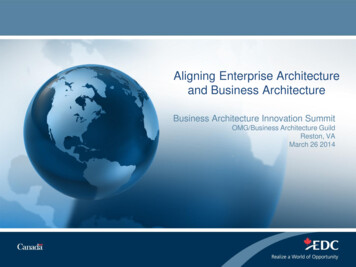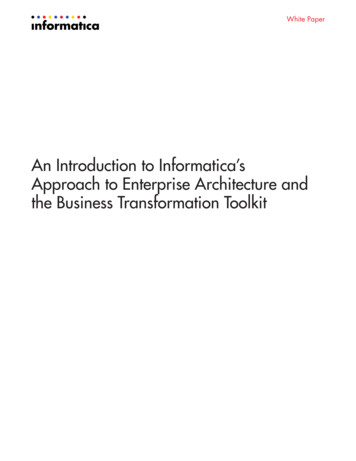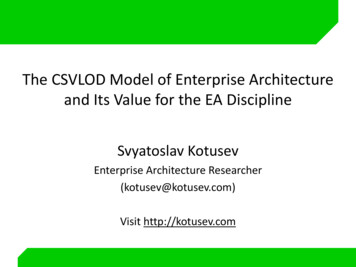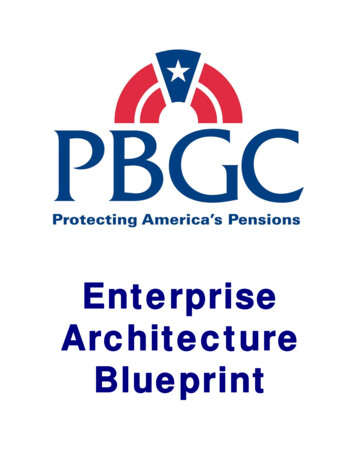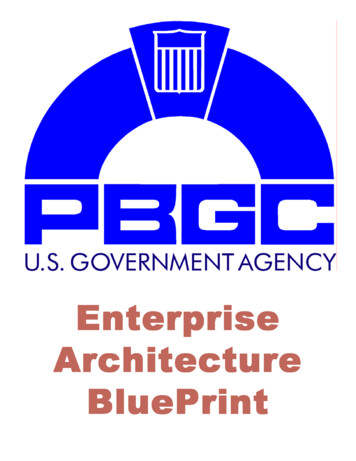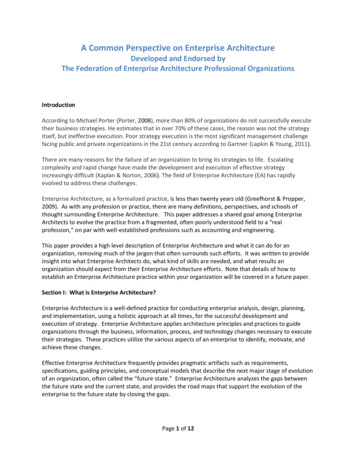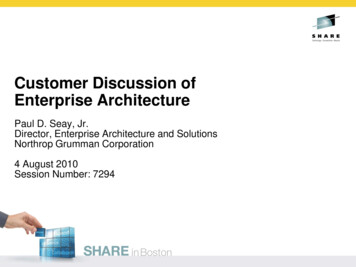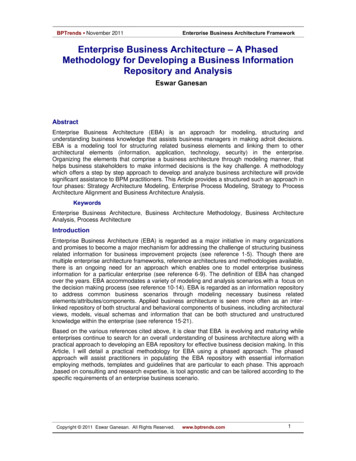
Transcription
BPTrends November 2011Enterprise Business Architecture FrameworkEnterprise Business Architecture – A PhasedMethodology for Developing a Business InformationRepository and AnalysisEswar GanesanAbstractEnterprise Business Architecture (EBA) is an approach for modeling, structuring andunderstanding business knowledge that assists business managers in making adroit decisions.EBA is a modeling tool for structuring related business elements and linking them to otherarchitectural elements (information, application, technology, security) in the enterprise.Organizing the elements that comprise a business architecture through modeling manner, thathelps business stakeholders to make informed decisions is the key challenge. A methodologywhich offers a step by step approach to develop and analyze business architecture will providesignificant assistance to BPM practitioners. This Article provides a structured such an approach infour phases: Strategy Architecture Modeling, Enterprise Process Modeling, Strategy to ProcessArchitecture Alignment and Business Architecture Analysis.KeywordsEnterprise Business Architecture, Business Architecture Methodology, Business ArchitectureAnalysis, Process ArchitectureIntroductionEnterprise Business Architecture (EBA) is regarded as a major initiative in many organizationsand promises to become a major mechanism for addressing the challenge of structuring businessrelated information for business improvement projects (see reference 1-5). Though there aremultiple enterprise architecture frameworks, reference architectures and methodologies available,there is an ongoing need for an approach which enables one to model enterprise businessinformation for a particular enterprise (see reference 6-9). The definition of EBA has changedover the years. EBA accommodates a variety of modeling and analysis scenarios.with a focus onthe decision making process (see reference 10-14). EBA is regarded as an information repositoryto address common business scenarios through modeling necessary business relatedelements/attributes/components. Applied business architecture is seen more often as an interlinked repository of both structural and behavioral components of business, including architecturalviews, models, visual schemas and information that can be both structured and unstructuredknowledge within the enterprise (see reference 15-21).Based on the various references cited above, it is clear that EBA is evolving and maturing whileenterprises continue to search for an overall understanding of business architecture along with apractical approach to developing an EBA repository for effective business decision making. In thisArticle, I will detail a practical methodology for EBA using a phased approach. The phasedapproach will assist practitioners in populating the EBA repository with essential informationemploying methods, templates and guidelines that are particular to each phase. This approach,based on consulting and research expertise, is tool agnostic and can be tailored according to thespecific requirements of an enterprise business scenario.Copyright 2011 Eswar Ganesan. All Rights Reserved.www.bptrends.com1
BPTrends November 2011Enterprise Business Architecture FrameworkEBA Phased MethodologyA working methodology for developing an EBA repository consists of four major phases oractivities: Strategy Architecture Modeling, Enterprise Process Modeling, Strategy to ProcessArchitecture Alignment and Business Architecture Analysis. These four phases arecomprehensive--strategy architecture modeling defines the organization’s goals , enterpriseprocess modeling describes the structure of process execution knowledge, alignment of strategyto process enables the measurement of performance, and business architecture analysisprovides the feedback necessary to perform ongoing improvement of the strategy architecture.This phased approach allows practitioners to move from the as is state to the future state of thebusiness improvement lifecycle.A snapshot of the four phased approach for EBA is described in the diagram below, followed bybrief explanation of each of the phases.Figure 1: Four Phased EBA MethodologyComposite Enterprise Business Architecture Framework and Meta-model InputsThis EBA methodology is backed by the Composite Enterprise Business Architecture (CEBA)Framework which consists of 12 elements that constitute three categories of business,specifically,Business Building Blocks (Business Motivation, Business Situation, BusinessLocation, Business Role Player, Business Commitment and Business Event), Business Inputsand Transformers (Business Resources, Business Information, Business Behavior and BusinessFunctions) and Business Value ( Business Offerings). The CEBA framework also includes aCopyright 2011 Eswar Ganesan. All Rights Reserved.www.bptrends.com2
BPTrends November 2011Enterprise Business Architecture Frameworkmeta-model, which is a network representation of the business elements that enables one tomodel the enterprise using meta modeling approach (see reference 7 for complete details).Phase I: Strategy Architecture ModelingStrategy Architecture modeling or ‘business strategy formalization’ is the initial step in the processof defining the EBA. Every enterprise has defined a strategy which is designed to providecustomer satisfaction and toward gaining a competitive advantage in its market. This phasedetails exactly how business strategy can be modeled –related to the enterprise’s vision, mission,values and goals, and structuring how business value is created for both the internal as well asexternal stakeholders.In this phase, the approach focuses on “Strategy Formalization” rather than “StrategyFormulation” - though there is an overlap, strategy formalization is all about understanding,documenting and aligning strategy of the enterprise thus capturing the business intent. Strategyformulation is defined as either the responsibility of the Corporate Planning team or topmanagement or business leader. Frequently strategy is maintained in the business leader’s mindand is not readily apparent. So in this phase, a business architect must interpret theorganization’s strategy, define the strategy statement, communicate the details to process teamsand document the link to operationalization of the business strategy. Balanced Scorecard,Business Motivation Model, SWOT Analysis etc are tools/approaches that can be used in thisphase.Also, the strategy architecture modeling phase is the time to generate an understanding of thebusiness environment, products and services, customer segments and operating model of theenterprise. A select list of tools/approaches like PESTLE analysis, product catalogue definition,customer segmentation, targeting and positioning, financial analysis etc. can be used in thisphase.Phase II: Enterprise Process ModelingEnterprise Process Modeling or ‘process architecture’ is the next logical and major step in theprocess of defining the EBA. Even though a process architecture definition effort can be carriedout in isolation (many a times this activity will be the starting point for the EBA effort), performingthis activity with an understanding of the business strategy and business model of the enterpriseas detailed in phase I adds immense value.Defining process architecture at the enterprise or business unit level help develop the businesscontext in which we understand the business value chain, value streams and the businessprocesses that are performed to achieve business goals. Process Architecture contributes to anunderstanding of ‘how’ the business functions in order to execute the business strategy. Thehierarchical breakdown of processes not only helps track business goals/strategies but also helpsdefine software requirements.Also, in this phase we generate an understanding of the business functions, businessorganizational structure and linking business processes and other business elements likebusiness events, organization role player, business unit, business location etc. Multiple tools areavailable on the market to develop process architecture content. A structured operating model,governance mechanism, modeling methodology, tool management and expert process modelingcommunity are a pre-requisite for this phase. See reference 22-28 for a brief definition ofEnterprise wide Process Modeling and Architecture.Phase III: Strategy to Process Architecture AlignmentThe third phase in the EBA methodology is linking business strategy and business processes (orbusiness behavior). This ‘Architecture Alignment’ phase helps in monitoring business strategyexecution. Executing Strategy or linking strategy to processes for translating strategies intoresults and effectively monitoring strategy execution have always been a challenge forenterprises. The elements of strategy must be deconstructed into operational aspects and thentracked for effective performance. Performance measures need to be defined and associated withCopyright 2011 Eswar Ganesan. All Rights Reserved.www.bptrends.com3
BPTrends November 2011Enterprise Business Architecture Frameworkbusiness goals, and these key performance indicators (KPI) are then tracked and reported formaking informed decisions by the business stakeholders. See reference 29 for a detailed note onthe linkage between KPI and EBA.Typically, a business architect would be involved in understanding the business motivationelements (business goals/strategy/business objectives/tactics) along with the business processesand identifying a performance management system for the enterprise. KPI identification, definitionand monitoring are applicable tool/approaches that are available for the business architect.Phase IV: Business Architecture AnalysisThe final phase in developing a practical business architecture is the ‘analysis of businessarchitecture’ phase in which an impact analysis between business strategy, business operatingmodel and information technology is performed (refer figure 2). The multiple business scenarios,which an enterprise faces, can be broadly grouped into business reorganization scenarios,business improvement scenarios, business change scenarios and IT led business transformationscenarios (see reference 16). All of these business scenarios consume a significant amount ofthe information required for analysis of the business and IT goals, capabilities, business behaviorand performance.Figure 2: EBA Impact Analysis overviewInformation that is gathered in a structured manner in the previous three phases is kept alive in abusiness architecture repository, and various informational views can be developed for thespecific business scenario. The Business Architecture analysis phase deals with the developmentof accurate views of the business scenarios/initiatives wherein tailored informational views areavailable to the appropriate stakeholder(s) responsible for business decision making.Linkage to Information, Application and Technology Architecture (as-is & to-bemodels)Business Architecture provides a platform for integrating business information with otherenterprise architectural pillars – information, application and technology architecture. Thisstructural analysis and the viewpoints developed out of EBA methodology provide the criticalCopyright 2011 Eswar Ganesan. All Rights Reserved.www.bptrends.com4
BPTrends November 2011Enterprise Business Architecture Frameworkinsights required by the Chief Strategy Officer, Chief Operations Officer and ChiefTechnology/Information Officer to conduct business impact analysis. Based on the businessscenario faced by the enterprise and available structured information from the businessarchitecture repository, the business architect can link the key decisions and their impacts toinformation, application and technology architectures. This provides the complete enterprisearchitecture view necessary for various stakeholders and will provide a strong foundation forexecution because the business architecture is developed on a structured methodology that willcarry out this linkage to other architectural pillars.Architecture GovernanceEBA Governance is all about governing the process for developing the business architecturerepository and, in an on-going basis, it addresses the two basic questions: what are the decisionsto be made? and who will make those decisions? Governance is applicable to the people,processes and tools involved in the EBA effort and can be managed centrally by a steeringcommittee led by the program sponsor. This activity is applicable in all four phases of themethodology. The typical decisions that are part of the EBA effort are related to the operatingmodel for the program, resource planning, support from stakeholders, methodology adoption andmaturity analysis.Business/IT Team AlignmentBusiness Analysis for IT application development and maintenance, if aligned with the EBA effort,will enable closer coordination in dealing with business scenario changes. Business and IT teamsshould coordinate to achieve business goals, and business architecture modeling paves the wayfor deciding on IT projects and programs.Need for Business ChangeBusiness Change Management is part and parcel of the modern corporate world. There shouldbe a business change methodology in place which assists stakeholders in structuring the changemanagement programs with respect to the various business scenarios faced by the enterprise.An EBA program must adhere to the overall business change methodology and the need forbusiness change. This also suggests the need to align the EBA program to other major initiativesthat run parallel in the enterprise, including compliance management, lean management or BPM,etc.Business Value Proposition ImpactsA Business Value Proposition articulated through a business case is a must to gain sponsorshipfor an EBA and other change management projects/programs. EBA methodology must havevalue to the stakeholders, and the effort should be quantifiable. A viable maturity assessmentmodel and KPI list for the EBA program must be defined and tracked effectively. This phasedmethodology for EBA repository development provides the ability to track the effort and quantifythe results.ConclusionThis Article provides a comprehensive survey of the EBA literature, and details a phasedmethodology for EBA content development for business decision making based on extensiveconsulting and applied research expertise. The phased approach described here is essential tothe effective implementation of whatever framework the enterprise adopts. As stated earlier, EBAis maturing, and it will be used more often than not as a key approach by the CxO community formanaging business information and knowledge management. EBA enables structural analysis ofthe business and provides views to stakeholders that assist them in making informed businessdecisions. In the future, the author will attempt to link EBA with the Decision Sciences,specifically, Behavioral Economics, and examine how it impacts enterprise decision making.Copyright 2011 Eswar Ganesan. All Rights Reserved.www.bptrends.com5
BPTrends November 2011Enterprise Business Architecture FrameworkReferences1. SOA Consortium (2007), Enterprise Architecture 2010 – Where EnterpriseArchitecture Means Business, available at:http://www.soablueprint.com/yahoo site admin/assets/docs/SOA C EA2010 release1 October 2007 full.29182943.pdf2. SOA Consortium (2010), Business Architecture: The Missing Link between BusinessStrategy and Enterprise Architecture – Practitioner Perspective on EnterpriseArchitecture in 2010, available at: http://www.soaconsortium.org/EA2010 Business Architecture.pdf3. William Ulrich (2008), Business Architecture Survey Results, BPMInstitutePublication, available at: le/businessarchitecture-survey-results.html4. Jeff Scott (2008), Business Architecture’s Time Has Come, Forrester Publication.5. Jeff Scott et al. (2011), The State of Business Architecture in 2011, ForresterPublication.6. Betsy Burton et al. (2010), Hype Cycle for Enterprise Architecture 2010, GartnerResearch Publication.7. Eswar Ganesan et al. (2008), Building Blocks for Enterprise Business Architecture,SETLabs Briefings, available at: businessarchitecture.pdf8. Deborah Weiss, Battleground of the Enterprise Architecture Frameworks, GartnerResearch Publication, available at, 9/teleconferences/attributes/attr 155698 115.pdf9. Roger Sessions, Comparison of the Top Four Enterprise Architecture Methodologies,available at, on.pdf10. Ralph Whittle and Conrad Myrick (2004), Enterprise Business Architecture: TheFormal Link between Strategy and Results, Auerbach Publications, CRC Press.11. Deborah Weiss (2007), Business Architecture Viewpoint: A Framework of Patterns,Services, Domains and Components, Gartner Research Publication.12. William Ulrich et al (2010), Defining Requirements for a Business ArchitectureStandard, OMG Publication, available at: http://bawg.omg.org/13. The Open Group Architecture Framework (TOGAF) Version 9.0, available at:www.opengroup.org14. Ken Orr (2007), Business Architecture: Linking Business, Data and Technology,Cutter Consortium Enterprise Architecture Executive Report, Vol.10.No.2.15. William Ulrich et al (2010), Business Architecture Scenarios, OMG Publication,available at: http://bawg.omg.org/16. Eswar Ganesan et al (2009), Applied Business Architecture, SETLabs Briefings,available at: ture.aspx17. Betsy Burton et al (2008), How to Develop Enterprise Business Architecture, GartnerResearch Publication.Copyright 2011 Eswar Ganesan. All Rights Reserved.www.bptrends.com6
BPTrends November 2011Enterprise Business Architecture Framework18. Ken Orr (2005), Business Enterprise Architecture Modeling, Cutter ConsortiumEnterprise Architecture Executive Report, Vol.8.No.3.19. Greg Sudderth et al (2010), Five Core Principles of Successful BusinessArchitecture, available at: -business-architecture.pdf20. U.S Department of Interior (2006), Enterprise Architecture (EA) In Action: TheMethodology For Business Transformation (MBT), U.S Department of InteriorPublication.21. Adrian Grigoriu (2011), A Comparison of Common Business Modeling Approaches toGODS Generic Business Architecture, BPTrends Publication, available Grigoriuph.pdf22. Eswar Ganesan (2011), Composite Enterprise Process Modeling (CEProM)Framework – Setting up a Process Modeling Center of Excellence using CEProMFramework, ICEIS 2011 Proceedings, available at: cuments/process-modeling-framework.pdf23. Eswar Ganesan (2011), A Practitioner’s Guide to Assess the Maturity andImplementation of Enterprise Process Modeling using CEProM AssessmentFramework, BPTrends Publication, available at:http://www.bptrends.com/deliver file.cfm?fileType publication&fileName ling%20Assessment%20Framework%2DGanesan%2Epdf24. Eswar Ganesan (2010), Process Modeling – Art and Science of UnderstandingBusiness, Requirements Networking Group Publication, available at:http://www.requirementsnetwork.com/node/267325. Eswar Ganesan (2011), Composite Business Process Modeling Framework,Requirements Networking Group Publication, available at:http://www.requirementsnetwork.com/node/268626. Eswar Ganesan (2011), Process Hierarchy and Granularity Definition in EnterpriseProcess Modeling, Requirements Networking Group Publication, available at:http://www.requirementsnetwork.com/node/269827. Eswar Ganesan (2011), What do you want to model as part of Enterprise ProcessModeling, Requirements Networking Group Publication, available at:http://www.requirementsnetwork.com/node/270428. Eswar Ganesan (2011), Enterprise Process Modeling – Importance of EnterpriseProcess Modeling and how it fits into Enterprise Modeling – A Research Note,Requirements Networking Group Publication, available at:http://www.requirementsnetwork.com/node/284629. Eswar Ganesan et al (2009), Key Performance Indicators Framework – A Method toTrack Business Objectives, Link Business Strategy to Processes and DetailImportance of Key Performance Indicators in Enterprise Business Architecture,AMCIS 2009 Proceedings, available at: http://aisel.aisnet.org/amcis2009/736/Copyright 2011 Eswar Ganesan. All Rights Reserved.www.bptrends.com7
BPTrends November 2011Enterprise Business Architecture FrameworkAuthorEswar Ganesan is a Business Architecture Consultant with Infosys Labs, Infosys Limited, India.Eswar has consulted clients across the globe in engagements related to business/processarchitecture and requirements engineering and has 5 years of experience in Business/ITConsulting. His core research interest is in the subject of Enterprise Business Architecture (EBA).His other areas of interest include process modeling, process analysis and industrial B2Bresearch. He has developed Composite Enterprise Business Architecture (CEBA) methodology, apractical approach for EBA and has multiple research publications to his credit. The author canbe reached at eswar ganesan@infosys.com or e.ganesan@gmail.com .BPTrends Linkedin Discussion GroupWe recently created a BPTrends Discussion Group on Linkedin to allow our members, readersand friends to freely exchange ideas on a wide variety of BPM related topics. We encourage youto initiate a new discussion on this publication or on other BPM related topics of interest to you, orto contribute to existing discussions. Go to Linkedin and join the BPTrends Discussion Group.Copyright 2011 Eswar Ganesan. All Rights Reserved.www.bptrends.com8
Phase I: Strategy Architecture Modeling Strategy Architecture modeling or 'business strategy formalization' is the initial step in the process of defining the EBA. Every enterprise has defined a strategy which is designed to provide customer satisfaction and toward gaining a competitive advantage in its market. This phase

